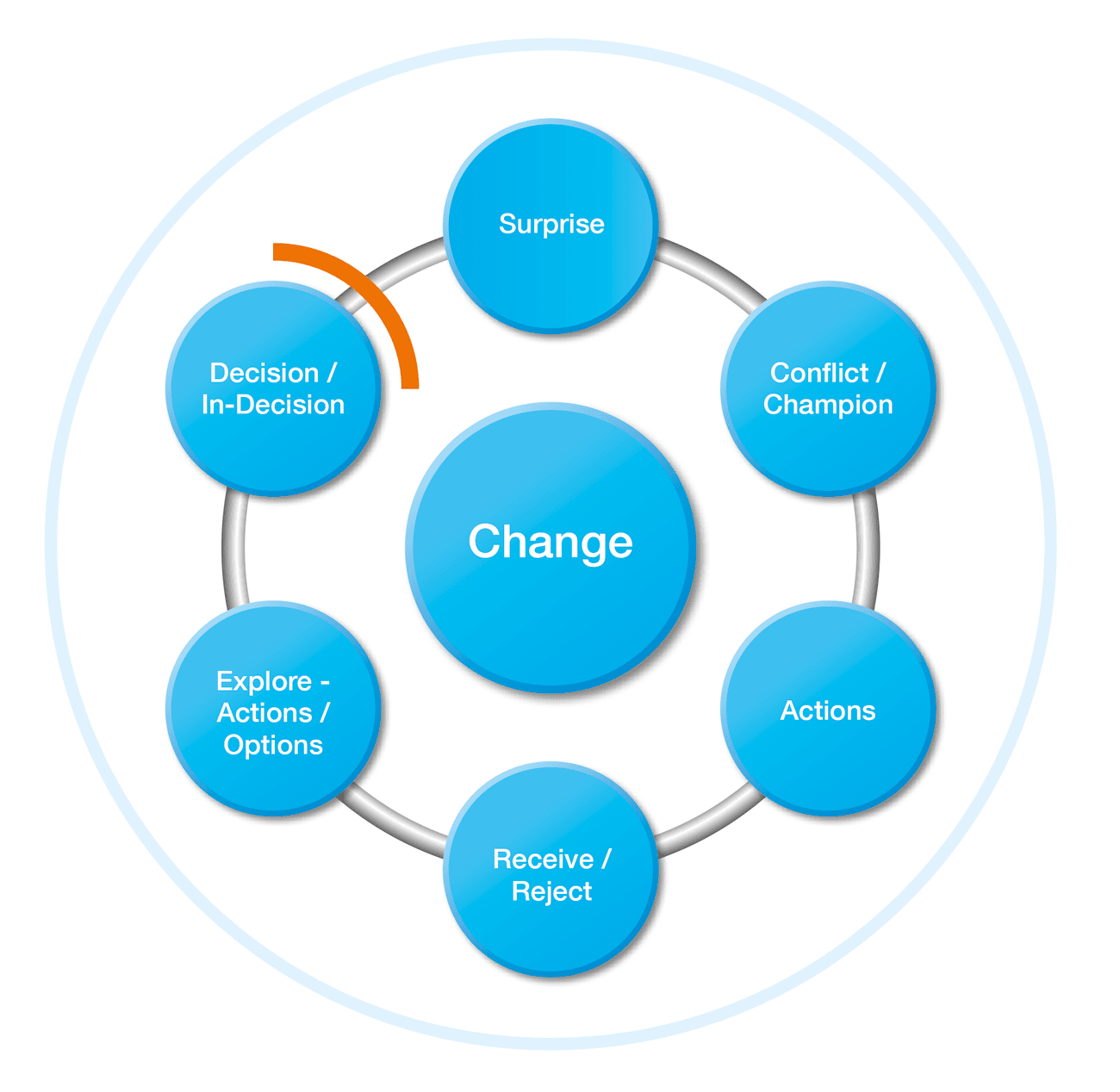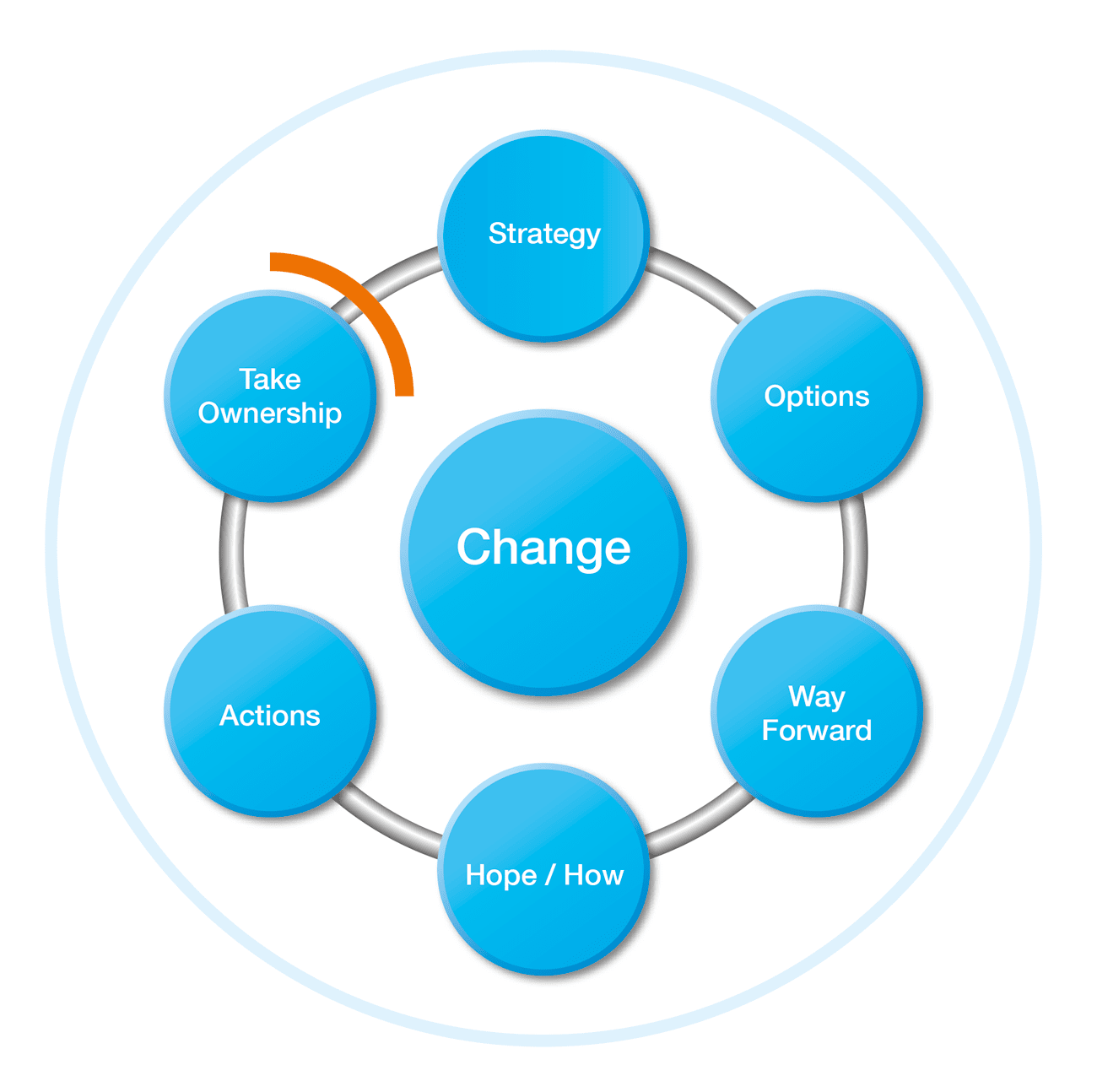Igniting a SPARK
26th May 2020 | Grant Van Ulbrich
How to introduce a collaborative change methodology to further support embedding of a sales academy into an organization.

Abstract
Change management models and leadership styles are not a one-size-fits-all approach. This project shows how I was able to embrace aspects of Wilkinson’s (2006) generative leadership style through ambiguity and create my own change management models. Setting out with a clear vision, and creating my own models, as a strategy (Kotter 2012) will reflect a leadership versus management style to ultimately help our sales teams learn how to navigate their feelings and emotions through the fear of change.
SCARED – SO WHAT became two new change management models designed to help sales leadership successfully launch a new SPARK Sales Academy learning methodology for Royal Caribbean Cruises Ltd, and stay true to their strategies and campaigns. When a much larger, unexpected change process occurred in the middle of this project, these models helped employees navigate the change process in a much simpler, easy-to-understand way. Change is constant – how you navigate the change makes it bearable and achievable.
“How will I introduce a collaborative change methodology to further support the embedding of the SPARK Sales Academy into our organisation?”
Simon Sinek (2011) tells us to start with “why”. My concern begins to formulate by asking myself, “Why did my sales leadership team not take up their own launch plans that they made for launching SPARK learning pathway one?” Perhaps I wasn’t clear on the instructions. Or perhaps, they didn’t understand “why” they were needing to implement this change within their own teams, themselves.
I’ve since learned that “not being able to articulate why the project is being done, puts it at risk of losing support and momentum and decreases it’s chance of success”, (Brown, Hyer and Ettenson, 2013). And that is exactly what happened. I failed to explain the why and went directly into the what and how.
Now that I understand the why, I will utilize Bassot’s (2016) teachings on reflection in and on action to help formulate my journey in documenting the project results. I will utilize McNiff’s (2017) “what, so what, and now what” model and merge with a portion of Gibb’s (1988) reflective cycle to frame my findings.
What is my concern?
My concern stems from my sales leadership team not following their own launch plans, and as a result, learning pathway one’s launch failed to ignite a SPARK. As I’ve uncovered above from Brown, et al, I didn’t explain why we were launching this new sales academy to our teams. I thought that it was obvious. My leadership interviews uncovered that people went back to their normal workloads and didn’t make the time for the launch to happen.
I am concerned that if the sales leadership does not understand why we are launching the second learning pathway, the same results that occurred when we launched the first learning pathway will re-occur. The question for this project is: “How will I introduce a collaborative change methodology to further support the embedding of the SPARK Sales Academy into our organisation?”
So, what did I do?
During our Master’s (Consalia, 2019) cohort in October, I found myself searching to link and connect the various models of leading change, and the change models themselves, to something more relevant that I could understand… and more importantly, relate to others. First was for me to understand how to explain “change” to my team in simplistic terms.
The SARA Curve (Rogel, 2010) posits that you have to be in shock and then dip down towards anger before hitting resistance and then going into a positive mindset of acceptance. I found it difficult to relate this change model to that which occurs in everyday work environments. Why? Because it’s saying you have to be angry and that there is no way for you to reject the change completely. There are different emotions that happen to people. This model was intended for bereavement.
The very same foundational curve from the SARA model, I found in Connor’s (2012) Positive Change Cycle. It is very similar in that it shows you might dip into a negative mood before eventually climbing into a positive mood. I argue that this is not accurate for every change process that occurs in work environments. Kouzes and Posener (2017) tell us: “Exemplary leaders embrace the commitment to Search for Opportunities to ensure that extraordinary things happen.” That is where I found myself, searching for an opportunity to make something new within a change-management model happen.
In leading change, a leader creates the vision and strategy for the team to manage and create plans and actions to achieve the end goal. (Kotter, 2012). Kotter (2014) also created eight Accelerators as a model for teams to follow the vision and implement a change management process. Likewise, Kurt Lewin’s Force Field Analysis (Burnes and Cooke, 2012), is another model that can be used together with Kotter’s.
I would recommend that Lewin’s model be used as a tool either before or during a change-management process. You can use it before to find out what could happen. Likewise, you can use it during a change process to find out what is happening. However, I still find that I need to be able to have a change process or model that I can relate to easily.
For me to absorb the new change management models and processes being taught (Consalia, 2019), my instructor looked at me and didn’t interrupt me. She knew that I was processing and reviewing all the new learning. She gave me time to think. (Kline, 2018). She gave me quiet time, so that I could finish and complete my thoughts. And then it came to me.
Fear is at the root of change and it’s called metathesiophobia. Why people at work do not action change can possibly be due to this fear of the change. Reflecting back on launching learning pathway one for SPARK, the leaders were stuck in one element of Bridges and Bridges (2017) three phases of transition. I identified this in the sales leaders’ interviews (see Appendix E) whereby through their own admission they couldn’t let go of the old system, schedule, routine and/or were in the neutral zone waiting for someone to help them into achieving their own launch plans. I did share the SARA Curve with them during the initial leadership workshop – but much like my own learning experience in the Master’s – it didn’t have the desired relevance.
SCARED
The emotions that I believe supported the behaviours expressed were Surprise, Conflict, Actions, Resistance, Exploration and Decision. Simply put, they were SCARED. And as I continued to explore this process, I came up with a model (Figure 1) to help people understand what could be happening to them during a change process.

Change is constant – how you navigate the change makes it bearable and achievable.
SCARED is a non-linear model that can resemble change in real life, at work moments, where people identify with fear. You can also see from the model over time that people can express neutral, positive, or negative reactions in their behaviour as each element applies to them in the cycle. Surprise can be positive or negative. People can be conflicted or champion the change. Actions will occur when people begin to ask questions or seek clarity of the change. People can become receptive or flat out reject the change being imposed upon them.
Unlike the SARA or Positive Change Cycles, you can reject the change outright. Those models don’t reflect that. Next, one might explore options or a way forward before coming to a decision point. In my SCARED model, during a change process, the goal is to break out of the fear of change with a favourable decision point. If one cannot, then they may repress themselves back into the SCARED cycle until they can. If they remain inside this cycle it could be due to indecision or absence of information. SCARED identifies the behaviours and moods that one might experience during an at-work change-management process.
Eight Accelerators
The next part is where I could use Kotter’s Eight Accelerators model to help people formulate their actions towards implementing the change process. However, that wasn’t resonating with me. I kept asking myself “So What?” Now I understand what’s happening to me during the change, so what do I do about it? And that’s when I came up with a second model of SO WHAT. (see Figure 2).

In the SO WHAT model, strategy may be the first step to begin with. And to add to your strategy you may need options or opportunities to enhance that change management strategy. Once you have your strategy and options, you quickly assess if this is the proper way forward for you. If not, then go back and rework your plan. If yes, then you stop and do a sense check to see if you have hope or know fully how you can move forward. Once you are sure of your plan then you need to take the actions necessary to enable your plan. Taking ownership will ensure that your plan succeeds. This is detailed further in the SO WHAT templates to help one complete their SO WHAT plan (see Appendix C). The combined models for a simple workplace change-management process comes together as SCARED – SO WHAT.
What happened?
This time when I launched learning pathway two for Account Management, I introduced my SCARED – SO WHAT change-management models. We took time to understand what would be happening to people when they introduce the new sales training and what behaviours their team members might be experiencing at different times along the way. We took time for them to formulate their SO WHAT plan and gave them templates for them to be able to create their own plan of action for implementing the change process.
Fear is at the root of change and it’s called metathesiophobia.
The acceptance of the SCARED – SO WHAT models was very positive. The sales leaders said they fully understood and identified with the fear of change as explained. They stated that they could understand what SCARED represented in terms of the thought and emotional reactions to change. Each one of the leaders formulated their launch plans and we documented them over the next few days and were set to launch.
A week later, I went to Lisbon, where I introduced the SCARED – SO WHAT models to a group of international agency representatives (IRs). From Moscow and St Petersburg, Russia all the way to Dubai, UAE, and South Africa, these 65 agents would be an incredible test to see how the SCARED – SO WHAT model would translate. And at the end of the conference I was again met with praise and excitement for expressing change management in a simple way. The Russian teams even asked if I would do webinars on the topic to help their team members embrace this new understanding. I was completely elated that I was able to implement a change-management process and models that people could easily identify with.
More change
On 13 November a different change element was introduced at work: workforce re-organization. As the company is in a state of growth, many business elements would be restructured and relocated to our global headquarters in Miami. This of course meant many redundancies in the international regions. It’s a normal business practice but fear for my colleagues and my own job became the centre point and all-consuming.
For the first time in my adult life I can say that I didn’t completely freak out with this ambiguous situation. I actually decided to champion the Generative leadership style (Wilkinson, 2006) and lead within my own SCARED – SO WHAT models. I took the time to review my own thoughts and behaviours and actions, and write them down and share with my spouse, mentor, and colleagues.
Was I:
- Surprised? Yes.
- Conflicted or Champion? Conflicted until more information came along.
- Actions: Asking questions, emails, phone calls, collecting information.
- Receptive or Rejective? Receptive as I was informed my role would be remaining.
- Explore: Many conversations to gain options, information, support for others.
- Decision: Favourable – embrace and move onto SO WHAT.
Now that I was past my own fear and comfortable with my SCARED feelings, I needed to move onto my SO WHAT. I was unable at that moment to move forward with the launching of SPARK learning pathway two as all timelines had frozen. I had to focus on the needs of my people and my job at hand.
And that is when I decided to start sharing the SCARED – SO WHAT model with the leaders again. We started to talk more about the fear of being scared and what it meant to each person. Through individual meetings and even full-on classroom sessions (see Appendix D), SCARED – SO WHAT was now starting to be proven useful in helping our team members in each department to understand their feelings and the developing situation that was happening to them and occurring around them.
We cannot use one change management process for every type of change situation.
This was now moving beyond just my sales leadership and sales teams but onto the entire EMEA members. From Spain and France, to Germany, Italy and even to the Nordics, people were uncovering their fears of the situation through SCARED and trying to get onward to their SO WHAT plans. I was invited by HR and my leadership to present to employees the new SCARED – SO WHAT models as a way of helping people identify and understand the change process. It was in simple terminology and transcended language and was helping people to absorb the changing environment (see Appendix G).
This entire process of introducing the SCARED – SO WHAT models has brought me sincere joy and a sense of fulfilment. In a time of unexpected crisis, I was able to take my own learnings and experiences, and lead the teams through ambiguity so that they could recognize and face their own fears enough so they could begin to take control of their own strategy to go forward. Helping myself and others in rationalizing what is happening to them through these models has left me with a sense of fulfilment to uplift others so they can succeed.
Evaluation
Gibb’s (1988) asks us to describe what was good and bad in the experience.
The good
Often, I had questioned myself when areas of higher education had perplexed me or made me feel inadequate. In this experience I learned that it was perfectly ok for me to take what I’ve learned, give myself time to think (Kline, 2018), and then transcribe it into my own ways of understanding and expression. That was very positive. And in doing so, I was able to take my vision and articulate it into a model that others in the workplace could understand and utilize easily – regardless of language.
Additionally, by developing my own change-management models I was able to stop myself from complete panic during a major change that was introduced to me as well as my team. As my spouse, mentor, and even my boss would say: “You have changed yourself dramatically. And it’s obvious that the SCARED model helped you clearly process this change so you could quickly move into your own SO WHAT.”
Out of all that has happened during this project, that bit is of itself a major win for me personally. I now have the ability to implement or receive change and use SCARED – SO WHAT as models to execute and navigate my own way through a change process. And what’s more, it’s already helping others to do the same for them across EMEA. This means to me that I am able to have a far greater impact on others than I had originally anticipated at the beginning of this project. SCARED – SO WHAT can work and can help people identify with their fears and answer that all-important question: “So what can I do about it?”

The bad
Time was against us during this project. Two months just wasn’t enough time to test whether implementing this new change process would have a positive or negative effect on the leadership team’s ability to launch the SPARK Sales Academy learning pathways.
Analysis
SCARED – SO WHAT was beneficial to help others during a critical time of panic and uncertainty in a workplace change. I could argue that the SARA Curve and Connor’s Positive Change Cycle still wouldn’t apply in this situation because it doesn’t allow for people to be a change champion nor to completely reject the change. SCARED fosters the emotions and actions someone could take whether neutral, positive, or negative and allows for complete change champion or a rejection and exit of the change as well.
I also find that there are people like me out there on my own teams. People who are trying to make sense of change and need simple methodologies and support mechanisms to help them understand. This is clear when people say, “That makes sense to me”, or “When you explain it that way, I completely understand.”
One of my sales leaders even told me that he was using the SARA Curve model with his team whenever a change took place. The team began to hate the model because it always forecasted that they would become angry and then resist before accepting the change. This simply isn’t correct, and it reminds me that we cannot use one change management process for every type of change situation.
Rogel (2010) uses the SARA Curve when assessing the responses a person may have from a 360-degree feedback session. In this he states a person may be in shock or denial of the feedback. But what happens when a person is in complete surprise and becomes a champion of the feedback? SARA Curve doesn’t allow for that.
Rogel is automatically stating that the 360-degree feedback may be negative and therefore the person must be in shock and then become angry. It’s a good approach, but it’s one view that may not permit a positive outcome. The SCARED model does allow for that.
Most people are fearful or nervous at best, when it comes to receiving feedback. I would argue the SCARED – SO WHAT models would be much more relevant to a 360-degree feedback session vs SARA Curve. What this experience does prove is that there is no one-size-fits-all change-management model nor leadership style. We simply need to find the ones that best suit the change that is being introduced.
Conclusion
The work is far from complete. I am, however, excited at the benefits the SCARED – SO WHAT models have produced thus far for myself and my colleagues. This has dramatically affected my own behaviour when change is introduced and is directed at me. I’ve proven to myself that I can have a shorter reaction time with a method to help me navigate my thoughts out of a fearful change process; and move onto my SO WHAT stage that we all may go through.
Going forward, I will continue using the models with the introduction, launches, and participation rates of the SPARK learning pathways two through six. Path two launched on 2 December, and team members are actively going through the learning courses. This is an immediate improvement, but more data will be necessary as time progresses. Before each new pathway launches, I will introduce SCARED – SO WHAT to the leadership as a change-management model and gain their active understanding and support to embrace the change.
I am very pleased with this project and feel that I have successfully led a new change process with my leadership and HR inviting me to share, and team members thanking me for helping them absorb the change. As Grant (2014) says, “The more you give, the more you want to do it – as do others around you.” I will continue to give the SCARED – SO WHAT methodology to my teams by sharing it and capturing in more data. It has for certain, changed my thinking. I’m no longer SCARED – and now well into my SO WHAT.
Editor’s note
Unfortunately, we don’t have the space to reproduce the Appendices as part of this synopsis. If you would like copies of the Appendices, which offer further details of these change-management models, please email editor@journalofsalestransformation and we will be happy to send you the full project.
References
Bassot, B (2016), The reflective journal, 2nd ed, London: Palgrave, pp.40-41.
Bridges, W and Bridges, S (2017), Managing Transitions, Making the Most of Change, 4th ed. Croydon: Nicolas Brealey Publishing, p.5.
Brown, K, Hyer, N and Ettenson, R (2013), “The question every project team should answer”, MIT Sloan Management Review, (online] 55(1), pp.49-57, available at: http://sloanreview.mit.edu.ezproxy.mdx.ac.uk/article/the-question-every-project-team-should-answer/, (accessed 7 December 2019].
Burnes, B and Cooke, B (2012), “Kurt Lewin’s Field Theory: A Review and Re-evaluation”, International Journal of Management Reviews, (online] pp.408-425, available at: https://onlinelibrary-wiley-com.ezproxy.mdx.ac.uk/doi/10.1111/j.1468-2370.2012.00348.x, (accessed 7 December 2019).
Connor, D (2012), “Change Is Easy When People Like It, Right?” Conner Partners, (online) Connerpartners.com, available at: https://www.connerpartners.com/frameworks-and-processes/change-is-easy-when-people-like-it-right, (accessed December 2019).
Consalia (2019), Module 4: Leading Collaborative Change (WBS 4909), 1st ed, UK: Consalia, pp.15, 20-23, 29-30, 36-47,60-88.
Gibbs, G (1988), Learning by doing: a guide to teaching and learning methods, London: FEU.
Grant, A (2014), Give and take, London: Phoenix / Orion Books, p.307.
Kline, N (2018), Time to think, London: Cassell Illustrated, pp.35-96.
Kotter, J (2012), Leading change, with a new preface by the author, Boston, MA: Harvard Business Review Press, p.73.
Kotter, J (2014), XLR8, Boston, MA: Harvard Business Review Press, pp.27-34.
Kouzes, J and Posner, B (2017), The leadership challenge, 6th ed. Hoboken, New Jersey: John Wiley & Sons, pp.24, 147-168, 235.
McNiff, J (2017), Action research for professional development, 2nd ed. Poole: September Books.
Rogel, C (2010), “Using the SARA Model to Learn from 360-Degree Feedback – DecisionWise”, (online) DecisionWise, available at: https://decision-wise.com/using-the-sara-model-to-learn-from-360-degree-feedback/ (accessed 7 December 2019).
Sinek, S (2011), Start with why, London: Portfolio Penguin, pp.37-51,154-171.
Wilkinson, D (2006), The ambiguity advantage, Basingstoke: Palgrave Macmillan, pp.68-69.


